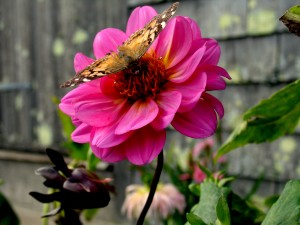 Only a short few days ago, dahlias were still blooming in Nantucket gardens. But our mild Autumn was brought to a halt last week with a sudden hard frost. Dahlias, being tropical flowers have since withered. But they’re not dead, only done for the season.
Only a short few days ago, dahlias were still blooming in Nantucket gardens. But our mild Autumn was brought to a halt last week with a sudden hard frost. Dahlias, being tropical flowers have since withered. But they’re not dead, only done for the season.
With a little work, you can save your Dahlias for next year! Dahlia tubers must be protected from freezing in order to survive the winter. Some gardeners have had success ‘leaving them where they lie’ and just covering them with an overturned nursery pot. I might not even attempt this approach in an area outside of a protected garden in town, but if you’re up for it, why not give it a try? Cut back most of the top growth and turn a nursery pot over above the plant. Keep it in place by pushing bamboo poles into the soil through the holes in the pot. If you like, add some additional insulation with straw or mulch inside the pot. The pot also keeps the newly emerging growth safe from deer and rabbits, just be sure it is in good contact with the soil.
If you are not a gambler, there is a safer way to overwinter Dahlias. Cut the top growth back to a few inches. Gently lift the whole tuberous mass from the soil with a garden fork. You don’t want to damage the tubers in any way, so be sure to dig at least a foot from the stalk on all sides. Once its out of the ground, gently remove most of the soil with your fingers. A quick rinse with the hose will get those nooks and crannies nice and clean. Take a good look at what you have. If there are any areas of insect damage, remove them entirely with a sharp knife. Any tubers that are at all soft, can also be removed, as they are likely to rot in storage. Allow the tubers to dry out for a few days in the shade.
Label each Dahlia with its variety and the date you stored it away. Pack them in a cardboard box wrapped in newspaper or peat moss. Whatever medium you store them in, try to keep it on the dry side of damp for the duration of the winter. Put the box in a place that is cool and dry, but where the temperature will not fall below freezing. Once a month or so, open the box and check them for any sign of mold, or excessive shriveling (a little is normal). If they seem to be too dry, give them a light misting. If they are too moist, leave the box open for a day or two before storing them again.
If all goes well, you can plant them in the ground again in late May and they will give you another year of amazing flowers!
